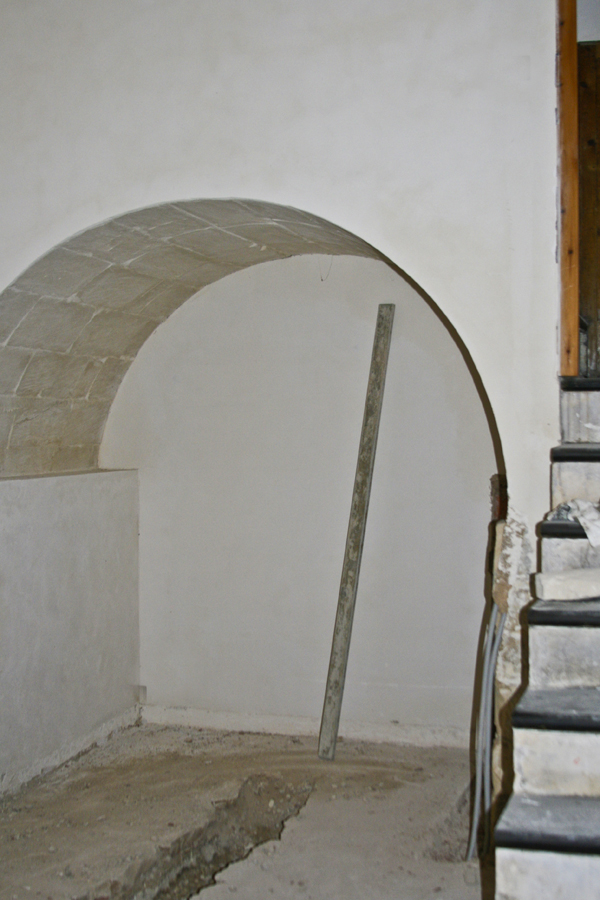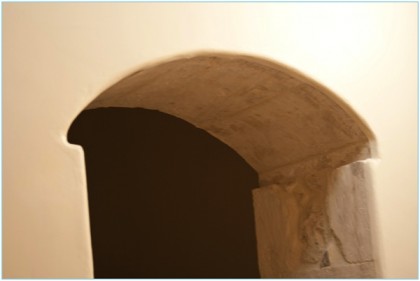April 12, 2010

…
Into the cramped space under this arch—hardly big enough for a closet—I plan to stuff an entire bathroom: sink, toilet, shower, heat rack, mirror, towel racks. The project manager is insisting on a bidet (he says no Italian can live without one), but you’d have to put your foot in the bidet to squeeze into the shower.
This is part of the cantina, the old wine cellar that is slowly morphing into guest quarters.
I plan to expose as much stone as possible inside and above the arch. The back wall, which needs to be waterproof, will be a sea of tiny tiles. Tiles the blue of a storm-tossed Ionian Sea.
Beastly expensive tiles.
I knew nothing about the cost when I ordered. I didn’t bother to ask the price. I figured: they’re just tiles made right here in Italy, not some expensive import. How much could a few little tiles cost?
The boxes finally arrived from Milan, along with the bill. My eyes popped. I had to read it over and over. I could feel my face on fire.
“Well, you ordered glass tiles,” the project manager says. What did you expect?”
I did notice how lustrous they were, but I had no idea they were glass.
I thumb through the instruction manual that comes with the tiles. The installation looks complicated. “Are you sure the mason is up to this?” I ask the project manager. The mason seems to have perfected the art of banging and pounding, but I’ve never seen him do anything delicate with his thick, calloused hands. Do I trust him with my treasures? Has he ever installed anything of the sort?
“Non preoccuparti,” says the project manager, winking. Don’t worry.
This is the favorite phrase down here. It usually means trouble.
But who am I to argue?
***
..
Click to comment.
Click to subscribe.
March 30, 2010
Surprise! The 20th-century layers have been chipped off my walls, and I think we’ve found—in addition to big old blocks of Norman stone—some traces of Arab architecture.
North African Moors ruled Sicily for only a couple of centuries more than a millennium ago, but their influence on the island was, and is, huge.
Before I show you my little discovery, take a good look, if you will, at these keyhole-shaped doorways in North Africa.


OK, now compare those doorways with the one below in my house. The arch shape turned up when we pulled off the modern wooden door frame. Don’t you think it looks vaguely Moorish in design?
 It’s not as beautiful as those North African doors, I know, and the curved thingamajig is way up top rather than in the middle of the arch, but still … it makes me wonder. It’s certainly not a pure Roman or Greek arch (more on that below). It’s not as beautiful as those North African doors, I know, and the curved thingamajig is way up top rather than in the middle of the arch, but still … it makes me wonder. It’s certainly not a pure Roman or Greek arch (more on that below).
I now have three of these vaguely Moorish arches on the top floor of my casa.
The house is a historical puzzle. The top floor, I’m quite sure, was built sometime soon after the 1693 earthquake that leveled not just Ragusa Ibla, but much of southeast Sicily. As I’ve mentioned earlier, the stone blocks in this doorway and elsewhere in the house were looted from the Norman castle that stood on this site and crumpled in that quake. (I know this only because neighbors have told me.)
So, assuming the above timeline, this means that 700 years after the Moors left Sicily, local Sicilian builders still carried traces of their Arab heritage in their builders’ DNA.
Everything here is so knotted and twisted together; it’s hard to tease out the many strands of history from all the superimposed cultures and styles. Layers upon layers—that’s what Sicily is all about.
The house becomes older the lower you go. The bottom floor used to be a cantina, a place where wine was made and stored (soon to be guest quarters). The arch down there seems Greco-Roman in style, an uninterrupted curve.

When was it constructed? Stay tuned. Maybe someday I’ll figure it out. Perhaps you have an insight?
***
For more on the Muslim rule of Sicily, click here.
***
Click to leave a comment.
Click to subscribe.
March 20, 2010
Chink chink. Whack whack. Hammers bounce off chisels. Lumps of plaster drop like overripe fruit exposing ancient stones, ghosts of centuries past.

I’m giddy, over the moon. And look! A stone arch where an ugly closet used to be! I love going backward in time.

But like the Sicilian saying goes: Quantu cchiù autu è lu munti, tantu cchiù profunna è la valli, the higher the mountain, the deeper the valley.
Neighbors—a stocky elderly couple—knock at the door one day just after I’ve arrived back from Rome. “Signora, there’s a problema.” They seem agitated. “Come see.”
I follow them up a flight of steps into their home. The houses in Ragusa Ibla are fitted together like jigsaw pieces; neighbors live over me, under me, to the right and to the left. The couple waves arms around and jabbers in sync. What in God’s name are they pointing at?
When my eyes adjust to the semi-darkness, I see what must be dozens of cracks like spider legs crawling over the walls. Bad news indeed, but what do these blessed spider legs have to do with me?
“Signora, all the pounding away in your house has ruined our walls.”
For a minute the room lacks oxygen. Are these cracks really new? Sicily is on a fault line. This could have happened years ago. I want to bring up these ideas, but of course I don’t. Instead I say in a voice sharp as a prickly pear, “Let me speak to the project manager. We’ll resolve this.”
Things are getting tangled up. Cu’ havi terra, havi guerra, Sicilians say, owning land is like fighting a war.
What will this cost? I’m hemoragging cash. The dollar is at an all-time low. I consult with Sicilians in the know.
Mason: No way we could we have done that. Impossibile. You’d be a fool to pay a centesimo.
Friend 1: Sicilians see Americans as a giant slot machine. Don’t pay.
Project Manager: It’s possible we did cause the cracks. We’ll never know. Pay up. Keep the peace.
Friend 2: It’s extortion, pure and simple.

Have they typecast me? The lady with the American dollars? Have I destroyed their walls? Do I now have two houses to restore? What to do?
Click here to comment.
March 17, 2010
Sicily is an old wall, pitted and crumby as stale cake.

Burning with Pompeian colors.

Glowing with graffiti.

Wrinkled as an ancient face.

Yellowed as old newsprint.

Fresh-plastered walls don’t have half the charm.
UNESCO money has poured into Southeast Sicily’s eight World Heritage towns. Let’s hope restorers don’t get too zealous.
***
Click here to comment. (See my last post for details about the comment contest!)
Click here to subscribe. (It’s free!)
March 10, 2010
xx
My husband, newly arrived on the scene, has clawed his way down to stone. I phone the project manager with the news.
The crew turns up the next day with hammers and chisels. Now that Kim is here, the garrulous workers completely ignore me, peppering him with questions and concerns—never mind that he doesn’t speak one iota of Italian.
Something about a manly presence in the house has lit a fire under the crew. They really get cracking. Chink chink chink. Chunks of plaster fall like overripe fruit, unveiling enormous blocks of tawny stone.

Madonna! They look pretty freakin’ old. I’m prone to wild mood swings in Sicily, and now I’m on the upswing.
“Stones from the old Norman castello!” say nosey neighbors who wander in the house through the open front door, wondering what all the racket is.
They tell me the entire neighborhood scavenged rubble from the castle that once stood on this site before it crumbled in Ragusa Ibla’s great earthquake of 1693.
 Norman castle in Ragusa Ibla before 1693 earthquake, copyright S. Tumino Finding the ancient Norman rocks is a delicious surprise.
There are more surprises to come in the near future, though none nearly so pleasant.
***
xxx
Win this book!!!!!
I love this tiny up-to-date (2009) guidebook. It packs in information in the form of many top 10 lists. It includes charming out-of-the-way places—the author knows the hidden nooks and crannies of Sicily—and a few fold-out maps.
HOW? Between now and March 26, write a comment on any of my blogposts. The best comment wins. (“Best” could be funniest, most enlightening, most touching…)
|
Subscribe to Baroque Sicily
Copyright reserved -
All photos and text on BaroqueSicily are Copyright of Jann Huizenga ©2009-2015, unless otherwise noted. Material may not be copied or re-published without written permission. All rights reserved.
|



 It’s not as beautiful as those North African doors, I know, and the curved thingamajig is way up top rather than in the middle of the arch, but still … it makes me wonder. It’s certainly not a pure Roman or Greek arch (more on that below).
It’s not as beautiful as those North African doors, I know, and the curved thingamajig is way up top rather than in the middle of the arch, but still … it makes me wonder. It’s certainly not a pure Roman or Greek arch (more on that below).















